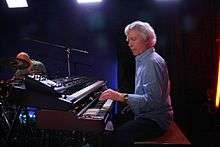Hugh Banton
| Hugh Banton | |
|---|---|
 Hugh Banton, organist with Van der Graaf Generator | |
| Background information | |
| Birth name | Hugh Robert Banton |
| Born |
April 1949 (age 67) |
| Occupation(s) | Organist, organ builder |
| Instruments | Organ, bass guitar, keyboards, bass pedals |
| Years active | 1968-present |
| Associated acts | Van der Graaf Generator |
Hugh Robert Banton (born April 1949, Yeovil, Somerset[1]) is a British organist and electronic organ builder, most widely known for his work with the group Van der Graaf Generator.
Career
Banton was born into a musical family, where his father played the piano and his mother regularly sang along to music on the radio. Two of his uncles were church organists. He first started playing the piano at the age of 4, beginning formal piano lessons at 7. He was equally influenced by the family classical record collection and by music heard on Radio Luxembourg. In his teens he studied classical piano & organ whilst attending Silcoates School in Yorkshire under Dr Percy G. Saunders, organist at Wakefield Cathedral, however he continued to enjoy both rock 'n' roll and classical music.[2]
After leaving school he trained as a television engineer with the BBC in Evesham, and subsequently in London, before joining Van der Graaf Generator in May 1968 when the group (then consisting of just Peter Hammill and Chris Judge Smith) moved from Manchester to London.[3] In performance with this group he played Farfisa and Hammond organs, adding a wide range of effects including phasing, tape echo, distortion and overdrive.
From 1970 he took over the bass-player roll within the group, using the organ foot pedals. He also played bass guitar on recordings. He modified his Hammond E112 organ to allow separate amplification, with different effects, of the output from the two keyboards and pedalboard, and added a remote reverb unit. In 1975 he began building a custom organ based on a Hammond but with added electronic oscillators to closely approximate a full pipe organ sound. Electronics, particularly the development of organs, having been a parallel interest since his early teens.
Banton changed career at the end of 1976 and left Van der Graaf Generator to work on the development, design and installation of electronic church organs for the Makin Organs company in Oldham, Lancashire, where he became Technical Director. In 1992 he set up his own company The Organ Workshop at Lymm in Cheshire, and latterly in Evesham, Worcestershire. His organs use digitally generated waveforms to emulate the sound of pipe organ stops, and a recent speciality is combining digitally generated organ stops within conventional wind-driven pipe organs, to create a larger hybrid instrument. His company have installed organs of all sizes both in the UK and abroad.
Since the reunion of Van der Graaf Generator in 2005 he has regularly contributed to concerts and recordings with former members, which continues as a trio with Peter Hammill and Guy Evans.
Discography
Solo
- J.S. Bach - The Goldberg Variations (organ) (2003)
- Gustav Holst - The Planets (organ) (2009)
Van der Graaf Generator
- Aerosol Grey Machine (1969)
- The Least We Can Do Is Wave To Each Other (1970)
- H to He, Who Am the Only One (1970)
- Pawn Hearts (1971)
- Godbluff (1975)
- Still Life (1976)
- World Record (1976)
- Time Vaults (1982)
- Maida Vale (1994)
- An Introduction: From The Least To The Quiet Zone (2000)
- The Box (2000)
- Present (2005)
- Real Time (2007)
- Trisector (2008)
- Live At The Paradiso (2009)
- A Grounding in Numbers (2011)
- ALT (2012)
- Do Not Disturb (2016)
Other Collaborations
- Fool's Mate (Peter Hammill) (1971)
- Chameleon in the Shadow of the Night (Peter Hammill) (1973)
- The Long Hello (Hugh Banton, Guy Evans, David Jackson, Nic Potter) (1973)
- The Silent Corner and the Empty Stage (Peter Hammill) (1974)
- Nadir's Big Chance (Peter Hammill) (1975)
- Psi-Fi (Seventh Wave) (1975)
- The Love Songs (Peter Hammill) (1984)
- Skin (Peter Hammill) (1985)
- Gentlemen Prefer Blues (Hugh Banton, Guy Evans, David Jackson) (1985)
- Everyone You Hold (Peter Hammill) (1997)
- The Union Chapel Concert (Guy Evans, Peter Hammill) (1997)
- Curly's Airships (Judge Smith) (2000)
References
- ↑ Christopulos, J. & Smart, P. (2005), "Van der Graaf Generator - The Book" (Published by "Phil and Jim") ISBN 0-9551337-0-X, page 17
- ↑ "Interview with Hugh Banton by Tim Locke". 5 October 2001. Retrieved 19 October 2012.
- ↑ Christopulos, J. & Smart, P. (2005), "Van der Graaf Generator - The Book" (Published by "Phil and Jim") ISBN 0-9551337-0-X, page 18
External links
- The Organ Workshop
- interview by Tim Locke at Van der Graaf Generator fan site
- The Goldberg Variations at Sofasound
- The Goldberg Variations, The Planets, at The Organ Workshop